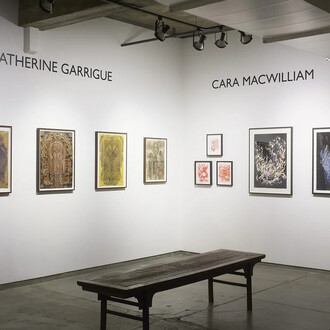M’onma was born in 1951 on the Japanese island of Hokkaido, known for its many temples and the destination of many pilgrimages. He had a fairly mundane childhood until an important visionary event took place in his life. He was in his twenties when something happened that shifted his world. As he sat at his desk in a studio his body became luminescent, glowed so intensely it obscured reality around him. He felt for the first time a presence come into his body and take over his hand guiding him into a drawing that had nothing to do with anything he had ever drawn before. It was intense and compulsive and non-representational. It was a drawing of raw energy. When the feeling lifted, he sensed that his life had now completely changed.
He drew after this first encounter, but the drawings were like his previous efforts, uninspired and more prosaic. He was unfulfilled and he became a wanderer, quitting his job, and moving back to Hokkaido where he would make pilgrimages to the Shinto temples, often sleeping in their austere shelters, and draw. He lived in a cycle of wandering, getting jobs in the city to acquire some money, and then returning to the mountains where he continued to draw. It was twenty years before the entity visited his body again.
This time he didn’t question or fight it. He allowed the images to come through his hand and he accepted that this otherness would create a vision of a parallel place without his being able to interpret or understand it. In the meantime, he had learned to live a solitary and dedicated life. He understood that he had to let go of his intellectual control when he made art.
He does not interfere with the flow of imagery or it stops. He empties himself of all interfering perceptions and allows the entity in, seeing it as a divine force moving through him. The entity guides his hand into expressive imagery that seems to reference what we know but goes further, populating this world with beings who on the surface seem familiar but who do not perform any of the actions or functions one would expect from them in the world we live in. The facially tattooed beings are not funny or whimsical, the bodies of the beings depicted are distorted but not grotesque, the faces are meditative and self-contained, some of the beings are even peaceful and angelic.
M'onma drew for decades before showing the drawings to anyone, feeling he was in service to a civilization in a parallel universe but without the keys to the codes depicted. He knows the drawings are about a balance between good and evil. He knows that although familiar images may emerge in the drawings, they do not serve the same functions they do in the world most people inhabit. The language is not real language, the crosses are not Christian, even the anatomy of the beings seem to reference humans but they are not human. The faces often have the same marks as the face tattoos of Ainu women; an animistic people who still live on the island of Hokkaido, his native home.
M'onma’s guided drawings take their place with other visionary works which have come to the fore over the past ten years. His drawings have been collected internationally.
















